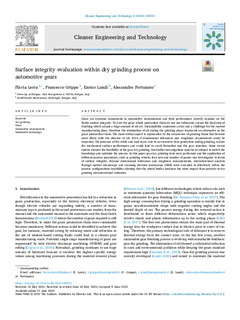| dc.rights.license | Attribution 4.0 International | * |
| dc.contributor.author | AAA, NNN | |
| dc.contributor.other | Lerra, Flavia | |
| dc.contributor.other | Landi, Enrico | |
| dc.contributor.other | Fortunato, Alessandro | |
| dc.contributor.other | Grippo, Francesco | |
| dc.date.accessioned | 2024-02-06T14:14:02Z | |
| dc.date.available | 2024-02-06T14:14:02Z | |
| dc.date.issued | 2022 | |
| dc.identifier.issn | 2666-7908 | en |
| dc.identifier.uri | https://hdl.handle.net/20.500.11984/6255 | |
| dc.description.abstract | Gears are essential components in automotive transmissions and their performance directly depends on the flanks surface integrity. To date the gears whole production chain do not use lubricants, except the final step of finishing which adopts a huge amount of oil yet. Sustainability represents a duty and a challenge for the current manufacturing lines, therefore the elimination of oil during the grinding phase represents an alternative in the gears production chain. The main critical aspect is represented by the occurrence of grinding burns that become more likely with the absence of oil. Even if dimensional tolerances and roughness requirements could be respected, the presence of the white and dark layer, due to an excessive heat generation during grinding, reduce the mechanical surface performance and could lead to crack formation and the gear rejection. Some recent studies showed the feasibility of the gear dry grinding, but further investigations must be developed to enrich the knowledge and optimize the process. In this paper gear dry grinding tests were performed and the application of different process parameters, such as grinding wheels, feed rate and number of passes was investigated in terms of surface integrity. Beyond dimensional tolerances and roughness measurements, microstructural analysis through optical microscope and scanning electron microscope (SEM) were executed to effectively define the process configurations feasibility showing that the wheel binder hardness has more impact than porosity in dry grinding microstructural outcomes. | en |
| dc.language.iso | eng | en |
| dc.publisher | Elsevier B.V. | en |
| dc.rights | © 2022 The Authors. Published by Elsevier B.V. | en |
| dc.rights.uri | http://creativecommons.org/licenses/by/4.0/ | * |
| dc.subject | Dry grinding | en |
| dc.subject | Gears | en |
| dc.subject | Automotive transmissions | en |
| dc.subject | Sustainable technology | en |
| dc.title | Surface integrity evaluation within dry grinding process on automotive gears | en |
| dcterms.accessRights | http://purl.org/coar/access_right/c_abf2 | en |
| dcterms.source | Cleaner Engineering and Technology | en |
| local.description.peerreviewed | true | en |
| local.identifier.doi | https://doi.org/10.1016/j.clet.2022.100522 | en |
| local.contributor.otherinstitution | Universitá de Bologna | es |
| local.source.details | Volume 9. N. art. 100522, 2022 | en |
| oaire.format.mimetype | application/pdf | en |
| oaire.file | $DSPACE\assetstore | en |
| oaire.resourceType | http://purl.org/coar/resource_type/c_6501 | en |
| oaire.version | http://purl.org/coar/version/c_970fb48d4fbd8a85 | en |
| oaire.funderName | European Commission | |
| oaire.funderIdentifier | https://ror.org/00k4n6c32 http://data.crossref.org/fundingdata/funder/10.13039/501100000780 | |
| oaire.fundingStream | RFCS | |
| oaire.awardNumber | RFCS-2018-847284 | |
| oaire.awardTitle | Improvement of the fatigue performance of automotive components through innovative ecofriendly | |
| oaire.awardURI | Sin información | |








